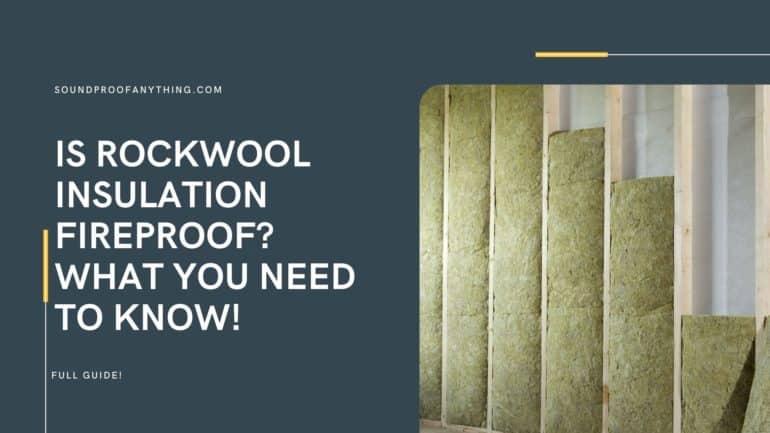Using the right kinds of insulation to prevent the spread of fire is essential when building a home, and some are better than others.
In this article, I will be going over how well Rockwool does in terms of flammability, if it’s fireproof or not, how all of this is measured (flame spread index), and compare it to other similar materials such as Fiberglass (in terms of flammability), and a lot more.
So, without any further ado, let’s get started!
Table of Contents
Is Rockwool Insulation Fireproof?
Rockwool, since it is made out of fire-resistant stone wool, is considered a non-flammable material that has a flame spread index of 25 and which can withstand temperatures of up to 1000°C for extended periods of time.
It’s worth mentioning, however, that no matter what insulation material you use, if the fire is strong enough and burns for long enough, at some point even Rockwool will start to burn (more on this later on).
What is Rockwool?

Also known as mineral wool, Rockwool is made out of rock fibers (volcanic rock and slag) that are spun and then given a specific shape (batt, pipe, and board forms).
Rockwool is a great sound absorber since it’s thick and has a lot of air pockets inside of it, and it’s also worth mentioning that you can get different densities and thicknesses depending on your needs, all of which affect how well it works in terms of thermal and sound insulation.
It’s not impermeable to water or vapor, and although it doesn’t absorb water like other types of wool, if it gets wet it won’t be able to insulate as well as when it’s dry (this applies to both thermal and sound insulation). Luckily, since it’s made of rock, once it dries it’s as good as new.
How a material’s flammability is measured: Flame Spread Index
I will now be talking about the flame spread index and what it represents, as well as the smoke development index, what the ideal ratings for both are, and more.
The flame spread index is determined by the distance that a flame travels along a test substrate in a specific timeframe to determine its propensity to burn and how rapidly it can spread flames.
It’s divided into these 3 classes:
| Class | Flame Spread Index |
| A | 0-25 |
| B | 26-75 |
| C | 76-200 |
- Class A fire ratings indicate a flame spread rating between zero and 25. Materials that fall into Class A or Class 1 include; brick, gypsum wallboard, and fiber cement exterior materials. These materials do not burn well and are very unlikely to contribute fuel to a fire.
- With a Class B or Class 2 fire rating, the flame spread rating would fall between 26 and 75. This rating is typical for slower-burning whole wood materials, such as planks that are in the same form as they were when they were cut from the tree.
- A Class C or Class 3 fire rating has a flame spread rating between 76 and 200, which incorporates building materials like plywood, fiberboard, and hardboard siding panels, as well as any of the faster burning whole woods.
What is a good flame spread rating?
The lower the Flame Spread index the better, since this means that the flame won’t travel and spread as rapidly. Class A materials, which have a rating of 0-25, do not burn well and are very unlikely to contribute fuel to a fire, which makes them the safest ones.
Smoke Development
Smoke-developed index (abbreviated SDI) is a measure of the concentration of smoke a material emits as it burns. Similar to how the Flame Spread Index is measured, it is based on an arbitrary scale that goes from 0 to 100, where a value of 0 represents extremely low smoke emission (asbestos-cement board, for example), and where a value of 100 represents the highest smoke emissions (red oak wood).
Rockwool, or Mineral Wool, since it’s essentially made out of stone, its emissions are very low, but it will still emit smoke.
Here’s a table with the flame spread and smoke development ratings of the most popular insulation materials:
| Material | Flame Spread Rating | Smoke Development |
| Mineral Wool (Rockwool) | 25 | 50 |
| Fiberglass | 25 | 50 |
| Spray Foam | 75 | 450 |
| Mass Loaded Vinyl | 25 | 250 |
| Cellulose | 25 | 50 |
Important: Rockwool will still catch on fire (eventually)
Even though Mineral Wool is made out of rock, if the fire is hot enough and burning for enough time, it will eventually catch on fire and burn.
However, it will do so much slower than almost any other material since it’s as fireproof as it gets.
When comparing it to spray foam, for example, even though spray foam has added chemicals to give it flame-retardant qualities, it will still burn a lot faster and way more violently, causing fire to spread much quicker.
This is why Rockwool is considered to be one of the best or even THE insulation material with the lowest flame spread rating.
Conclusion
Mineral Wool is probably the best insulation material you can use if you want to make your house, building, etc., as fireproof as possible since it acts as a fire-blocking agent.
Fiberglass shares very similar characteristics but it’s made out of glass and not rock, so it doesn’t handle high temperatures for extended amounts of time as well as Rockwool.
Just as a reminder: Rockwool may eventually catch on fire if exposed to high enough temperatures for extended amounts of time, but it won’t really help a flame spread.
In short, Rockwool is the best insulation material you can get if you want something that is fireproof.
Last Updated on August 29, 2022 by Facundo
